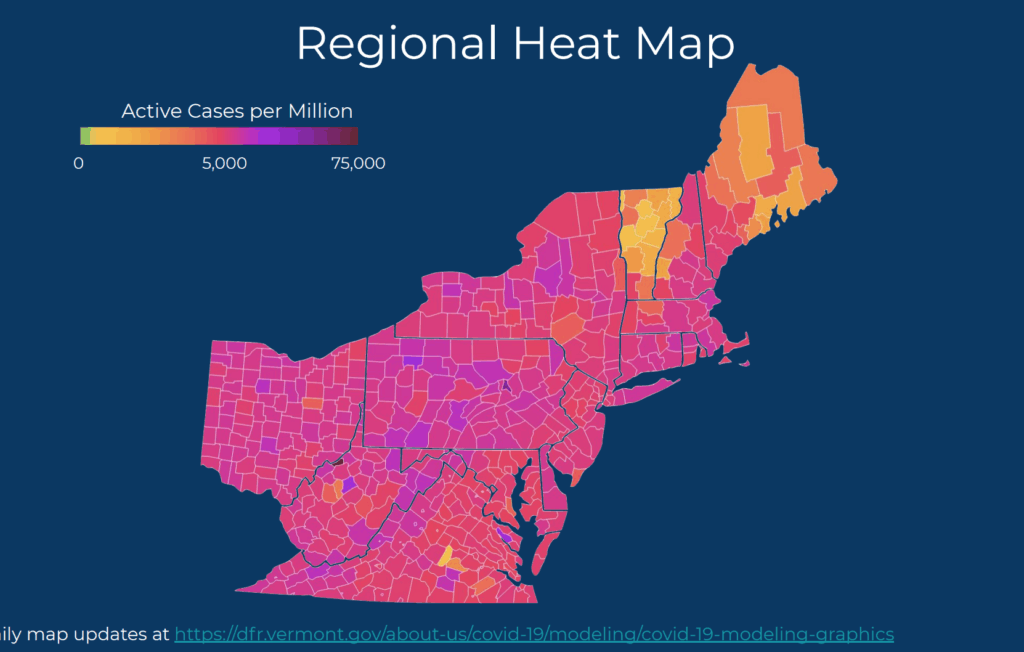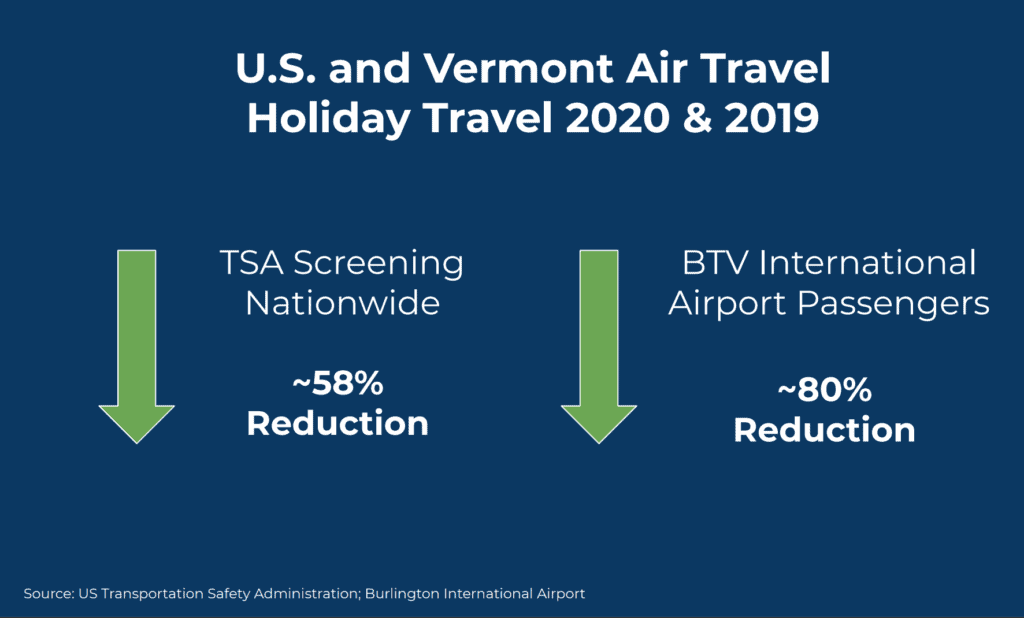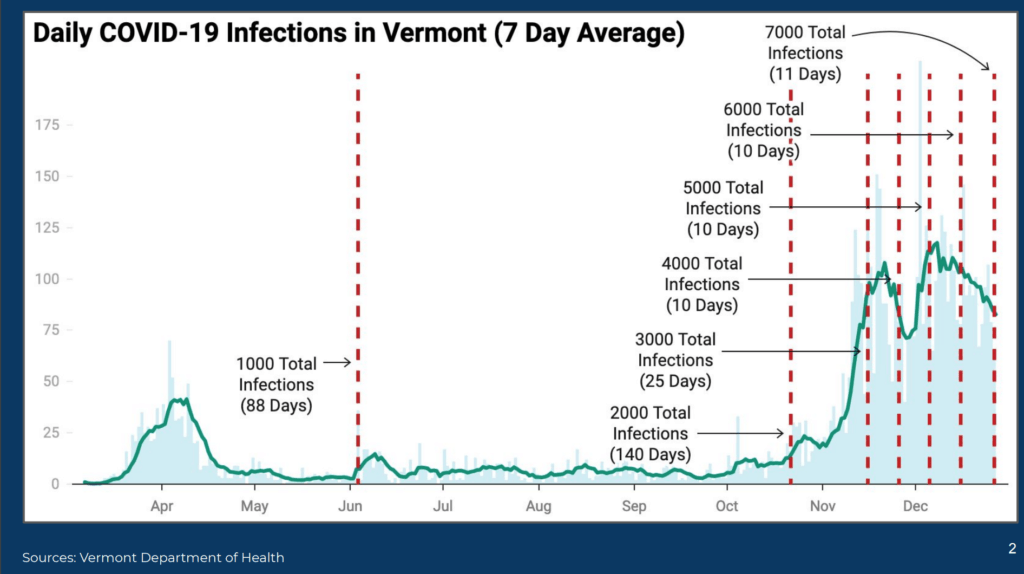
Officials urge vigilance, adherence to Covid travel and gathering guidelines
By Polly Mikula
For the second straight week, Vermont and the Northeast region have seen Covid cases decline.
Governor Phil Scott called the trend a “promising sign,” before cautioning listeners at his regular Covid-19 press conference, Tuesday, Dec. 29, that it was “too early to see impact of holiday travel and larger gatherings.”
He said, “Our hope is that we’ll continuing seeing a decline or at least a plateau in case numbers, but admittedly we’re holding our breath.”
State Health Commissioner Mark Levine, added: “Throughout these next few months, while we’re still in the depths of the pandemic, we must continue to keep a steady hand on the wheel. It’s too early to know if we will see an increase or not in cases following the holidays, but the projections do look favorable.”
Officials said the upcoming New Years holiday will be another test and appealed to Vermonters and visitors to remain vigilant and adhere to travel and gathering guidelines.
“The end of 2020 is a day many of us are anxious to celebrate and begin our look toward brighter days again,” Levine said. “So I’m making an appeal to all to make that happen: follow the guidance and limit gatherings, and if you must gather, to do so with no more than one trusted household outside of your own. Reduce your exposure as much as possible and consider getting a test following any get togethers… keep in mind this simple guidance: Masks on faces, 6-foot spaces, uncrowded places.”

Michael S. Pieciak, commissioner of the Vermont Dept. of Financial Regulation, noted, “As terrible as 2020 has been, Vermonters have many reasons to look back on the year with pride and to look forward with optimism for the year ahead.”
While Vermont added another 1,000 cases in just the past 11 days, bringing the total to 7,000 cases since the beginning of the pandemic, that remains a relatively low figure. “To put this in a more helpful perspective,” Pieciak said. “Maine has recorded more cases than that [7,000] in just the past three weeks and New Hampshire just the past two weeks. So Vermont continues to maintain a very low case count both in the aggregate and on a per capita basis.”
Maine and New Hampshire have populations roughly twice as large as Vermont but have been averaging 433 cases per day, and 612 cases per day, respectively, according to the New York Times. Vermont’s average is 84.
However, December has been the deadliest month in Vermont since the beginning of the pandemic with 52 deaths this month — more than a third of the state’s 129 total deaths.

Of this month’s deaths, 10 have died in the past five days and 85% of the deaths were connected to long-term care facility, Levine added. That’s compared to 70% of the total deaths being among residents of long-term care facilities, he said.
Levine emphasized that the deaths at long-term care facilities are not a reflection of a poor facility or staffing, but rather a result of the virus being more prevalent in our communities and, thus, leading to more exposure, which affect vulnerable populations more severely leading to higher rates of illness and death.
“Deaths are almost exclusively among Vermonters age 60 and older. Only seven of the 129 deaths have been among Vermonters age 30-59,” Levine noted.
This data has informed state officials on whom to prioritize for vaccinations. “Our main focus is on reducing hospitalizations and saving lives. Those who are at the greatest risks, are the oldest age bands and those with chronic conditions,” Levine continued.
However, “there are over 400,000 Vermonters who, when you survey them, would tell you they fit the criteria of age over 65 and/or a chronic condition,” Levine said.
Mike Smith, secretary of the Agency ofHuman Services, further explained the state’s vaccination plan and prioritization of population subsets.
The completion of priority group 1a (vaccinating healthcare workers and those in long-term care facilities) marks the beginning of the mass vaccination program, Smith said at the press conference Tuesday.
“Vaccines will be prioritized and given based on age. Because the older you are the more vulnerable you are to Covid-19, and it meets our prime objective, which is protecting lives. It’s the easiest way to administer vaccines, and it’s the easiest for the public to understand,” he said.

“There will be age bands established as to when you will be eligible to be vaccinated. For example, 75-plus will be the first to get the vaccine after the completion of 1a, then 70 and older, then 65 and old, and so on. Underlying conditions will be a priority no matter what age, and those conditions will be clearly defined,” he said.
“What we are trying to do is design a system that is easily implemented, easily understood and prioritizes our primary goal of protecting lives,” Smith summarized, adding that “definitions such as ‘essential worker’ or ‘frontline worker’ often cause confusion and unnecessary divisiveness and doesn’t put enough emphasis on our primary goal of saving lives.”
Smith reported that 9,751 Vermonters have been vaccinated, so far — 14.8% of priority group 1a — with approximately 8,000 of those being healthcare workers, 900 EMS workers, and 900 at long-term care facilities through the pharmacy care program. He also noted that pharmacies have 72 hours to report to the federal government, which creates a significant lag time in that data. “In fact, by Jan. 8 we expected to be finished providing the first dose of the vaccine to all but one of the residents of skilled nursing facilities where the frailest of the elderly often reside,” Smith said.
As of Tuesday, 19 of 37 skilled nursing facilities have received the first dose of vaccine, he added. And by the end of January, all in priority group 1a should have received at least their first dose, and many their second dose, including most in skilled nursing facilities, Smith said.




